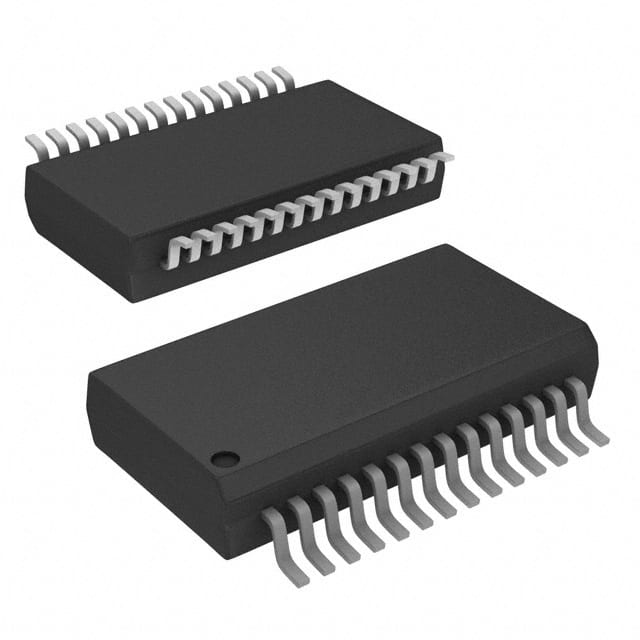Xem thông số kỹ thuật để biết chi tiết sản phẩm.

PIC16F73-I/SS
Product Overview
Category
The PIC16F73-I/SS belongs to the category of microcontrollers.
Use
This microcontroller is commonly used in various electronic applications that require embedded control and processing capabilities.
Characteristics
- Low power consumption
- High performance
- Small form factor
- Wide operating voltage range
- Integrated peripherals for enhanced functionality
Package
The PIC16F73-I/SS is available in a SSOP (Shrink Small Outline Package) package, which provides a compact and space-saving solution for PCB designs.
Essence
The essence of the PIC16F73-I/SS lies in its ability to provide efficient and reliable control and processing capabilities in a small and low-power package.
Packaging/Quantity
The PIC16F73-I/SS is typically packaged in reels or tubes, with a quantity of 250 units per reel/tube.
Specifications
- Microcontroller architecture: RISC
- CPU speed: Up to 20 MHz
- Program memory size: 4 KB
- RAM size: 192 bytes
- Number of I/O pins: 22
- Analog-to-Digital Converter (ADC): 8 channels, 10-bit resolution
- Serial communication interfaces: USART, SPI, I2C
- Timers/Counters: 3 timers/counters
- Operating voltage range: 2.0V to 5.5V
Detailed Pin Configuration
The PIC16F73-I/SS has a total of 28 pins, each serving a specific purpose. The pin configuration is as follows:
- RA0 - Analog Input/Output
- RA1 - Analog Input/Output
- RA2 - Analog Input/Output
- RA3 - Analog Input/Output
- RA4 - Digital Input/Output
- RA5 - Digital Input/Output
- VSS - Ground
- MCLR/VPP - Master Clear/Input for Programming
- RB0/INT - Digital Input/Output/External Interrupt
- RB1 - Digital Input/Output
- RB2 - Digital Input/Output
- RB3 - Digital Input/Output
- RB4 - Digital Input/Output
- RB5 - Digital Input/Output
- RB6 - Digital Input/Output
- RB7 - Digital Input/Output
- VDD - Power Supply
- OSC1/CLKIN - Oscillator Input
- OSC2/CLKOUT - Oscillator Output
- RC0 - Digital Input/Output
- RC1 - Digital Input/Output
- RC2 - Digital Input/Output
- RC3 - Digital Input/Output
- RC4 - Digital Input/Output
- RC5 - Digital Input/Output
- RC6/TX/CK - Digital Input/Output/Transmit Data/Clock
- RC7/RX/DT - Digital Input/Output/Receive Data
- VSS - Ground
Functional Features
The PIC16F73-I/SS offers a range of functional features that enhance its usability and versatility in various applications:
- High-speed processing capabilities
- On-chip memory for program storage and data handling
- Integrated analog-to-digital converter for sensor interfacing
- Multiple communication interfaces for seamless connectivity
- Timers/counters for precise timing and event management
- Low-power modes for energy-efficient operation
- Enhanced security features for code protection
Advantages and Disadvantages
Advantages
- Compact size and low power consumption make it suitable for portable and battery-powered devices.
- Wide operating voltage range allows for flexibility in different power supply scenarios.
- Integrated peripherals reduce the need for external components, simplifying circuit design and reducing costs.
- High-performance RISC architecture enables efficient execution of complex tasks.
Disadvantages
- Limited program memory size may restrict the complexity of applications that can be implemented.
- Relatively small RAM size may limit the amount of data that can be processed simultaneously.
- Lack of advanced features found in more powerful microcontrollers may limit its use in certain demanding applications.
Working Principles
The PIC16F73-I/SS operates based on the principles of a RISC (Reduced Instruction Set Computer) architecture. It executes instructions stored in its program memory to perform various tasks. The microcontroller interacts with external devices through its I/O pins, utilizing integrated peripherals such as timers, ADC, and communication interfaces. By following the instructions provided by the program code, the PIC16F73-I/SS can control and process data according to the desired application requirements.
Detailed Application Field Plans
The PIC16F73-I/SS finds applications in various fields, including but not limited to:
- Home automation systems
- Industrial control systems
Liệt kê 10 câu hỏi và câu trả lời thường gặp liên quan đến ứng dụng PIC16F73-I/SS trong giải pháp kỹ thuật
What is the maximum operating frequency of PIC16F73-I/SS?
- The maximum operating frequency of PIC16F73-I/SS is 20 MHz.Can PIC16F73-I/SS be used for analog-to-digital conversion?
- Yes, PIC16F73-I/SS has an integrated 8-bit analog-to-digital converter (ADC).What are the available communication interfaces on PIC16F73-I/SS?
- PIC16F73-I/SS supports USART, SPI, and I2C communication interfaces.Is it possible to program PIC16F73-I/SS using C language?
- Yes, PIC16F73-I/SS can be programmed using C language with the appropriate compiler.What is the maximum number of I/O pins on PIC16F73-I/SS?
- PIC16F73-I/SS has a total of 22 I/O pins.Can PIC16F73-I/SS operate at low power?
- Yes, PIC16F73-I/SS features low-power modes for energy-efficient operation.Does PIC16F73-I/SS have built-in timers and counters?
- Yes, PIC16F73-I/SS includes multiple timers and counters for various timing applications.What is the flash memory size of PIC16F73-I/SS?
- PIC16F73-I/SS has 4 KB of flash memory for program storage.Can PIC16F73-I/SS be used in automotive applications?
- Yes, PIC16F73-I/SS is suitable for automotive applications with proper environmental considerations.Are there any development tools specifically designed for PIC16F73-I/SS?
- Yes, Microchip provides development tools such as MPLAB IDE and PICkit programmers for PIC16F73-I/SS.

